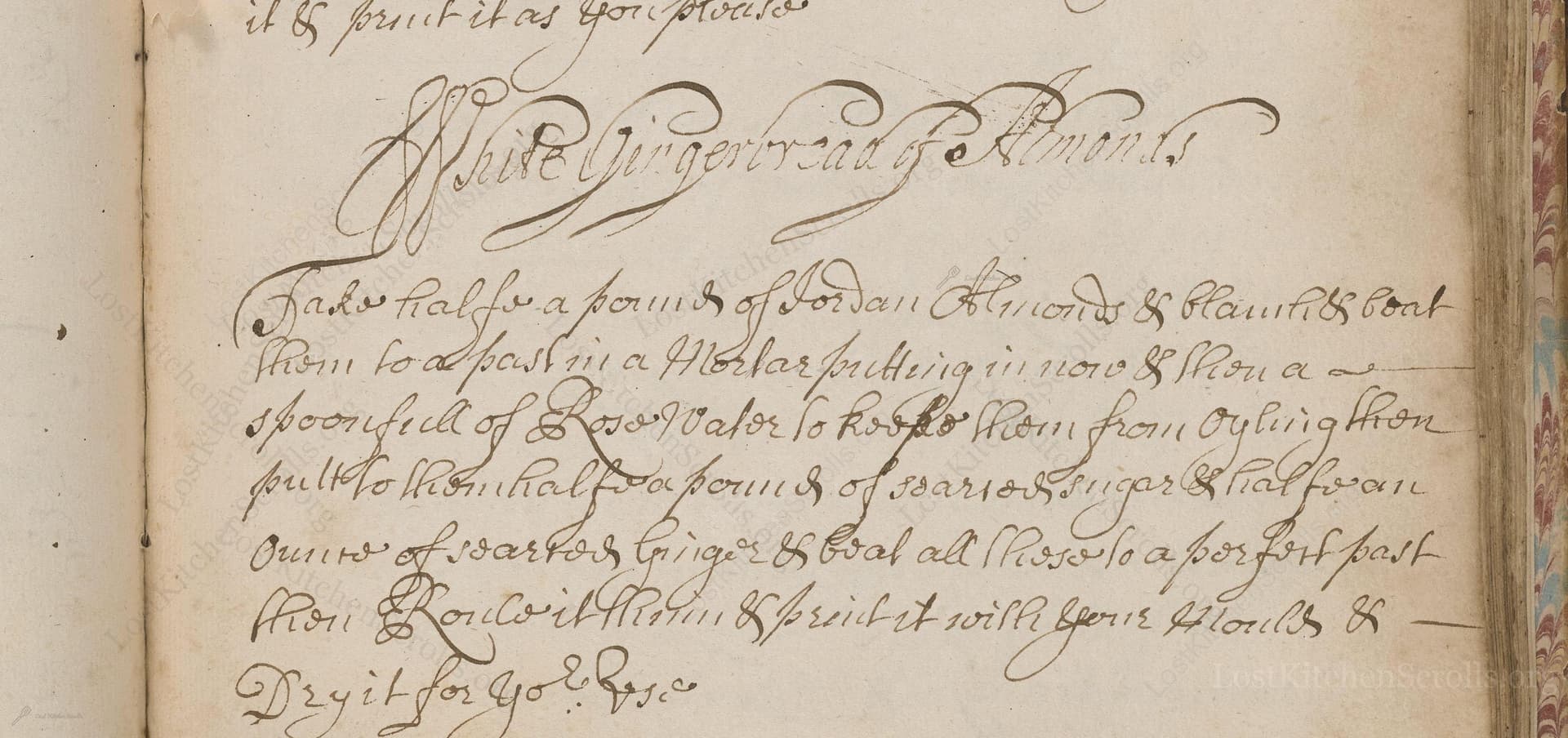White Gingerbread Of Almonds
From the treasured pages of Cookery and medicinal recipes by Kendall Rose and Anne Cater
Written by Rose Kendall, Anne Cater, Elizabeth Clarke, Anna Maria Bold

White Gingerbread Of Almonds
"Take half a pound of Iordan Almonds & Blanch & beat them to a past in a Mortar putting in now & then a spoonfull of Rose Water to keep them from Oyling then put to them half a pound of Sarrie Sugar & half an Ounce of Scarce Ginger & beat all these to a perfect past then Roul it thin & print it with your Moulds & Dry it for use"
Note on the Original Text
Recipes from this period were written for those already familiar with kitchen skills—hence the brevity and lack of exact measurements for all steps. Spelling is often phonetic ('Sarrie Sugar' is 'sifted sugar' or 'fine sugar'; 'Scarce Ginger' means 'finely sifted' or 'scarcely ground' ginger), and quantities tend to follow the ratio of ingredients instead of precise instructions. These manuscripts served less as textbooks and more as memory aids or reminders—making them wonderfully evocative, if sometimes cryptic, windows into the kitchens of the past.

Title
Cookery and medicinal recipes by Kendall Rose and Anne Cater (1712)
You can also click the book image above to peruse the original tome
Writer
Rose Kendall, Anne Cater, Elizabeth Clarke, Anna Maria Bold
Era
1712
Publisher
Unknown
Background
Step into the inviting kitchens of the past with this enchanting collection of culinary wisdom from England's early modern era. Crafted by a talented array of women, this book promises savory pies, sweet confections, and secret family recipes—an aromatic tour through centuries-old feasts sure to delight the curious palate.
Kindly made available by
Folger Shakespeare Library
This recipe comes from an English manuscript collection spanning roughly 1675 to 1750, associated with several women: Rose Kendall, Anne Cater, Elizabeth Clarke, and Anna Maria Bold—testament to the community and collaborative nature of historical recipe-keeping. Known as 'white gingerbread,' this recipe is markedly different from the dark, molasses-rich gingerbreads we expect today. Instead, it highlights luxurious imported ingredients—almonds, sugar, ginger, and fragrant rose water—and blurs the lines between confectionery and pastry. Such recipes were often served at the conclusion of banquets or on special occasions, showcasing both wealth and culinary skill.

In its time, this recipe would have called for a sturdy mortar and pestle for pounding almonds and sugar to paste—a laborious but meditative task. Rose water was a prized flavoring, and fine sugar would have been grated or pounded by hand. Pastry molds or hand-carved wooden stamps would imprint ornate patterns on the gingerbread, and sheets were probably laid on racks or trays to dry in a cool, airy room.
Prep Time
30 mins
Cook Time
0 mins
Servings
18
We've done our best to adapt this historical recipe for modern kitchens, but some details may still need refinement. We warmly welcome feedback from fellow cooks and culinary historians — your insights support the entire community!
Ingredients
- 8 ounces Jordan almonds (or regular blanched almonds as substitute)
- 1 tablespoon (0.5 fl oz) rose water
- 8 ounces fine (castor) sugar
- 0.5 ounces ground ginger (or a bit less if using very potent ginger)
- Extra flour or parchment for rolling out (to prevent sticking, optional)
Instructions
- Begin with 8 ounces of blanched Jordan almonds.
- To blanch, briefly boil the almonds and slip off their skins.
- Place them in a mortar (or a modern food processor) and grind to a smooth paste, adding a tablespoon of rose water at intervals to keep the mixture from becoming oily.
- Add 8 ounces of fine (castor) sugar and 0.5 ounces of ground ginger, and continue to blend or pound until you achieve a uniform, smooth paste.
- Roll the paste out thinly—about 1/8 inch is good—between two sheets of parchment to avoid sticking.
- Use decorative cookie molds or a patterned stamp to imprint designs onto the paste.
- Allow the shaped pieces to dry at room temperature until firm, which may take several hours or overnight, depending on humidity.
Estimated Calories
80 per serving
Cooking Estimates
Preparing the dough and shaping the sweets takes about 30 minutes. There is no cooking involved. The candies need to dry at room temperature for several hours or overnight, but this is just drying time. Each piece has about 80 calories and the recipe makes about 18 pieces.
As noted above, we have made our best effort to translate and adapt this historical recipe for modern kitchens, taking into account ingredients nowadays, cooking techniques, measurements, and so on. However, historical recipes often contain assumptions that require interpretation.
We'd love for anyone to help improve these adaptations. Community contributions are highly welcome. If you have suggestions, corrections, or cooking tips based on your experience with this recipe, please share them below.
Join the Discussion
Rate This Recipe
Dietary Preference
Main Ingredients
Culinary Technique
Occasions

Den Bockfisch In Einer Fleisch Suppen Zu Kochen
This recipe hails from a German manuscript cookbook compiled in 1696, a time whe...

Die Grieß Nudlen Zumachen
This recipe comes from a rather mysterious manuscript cookbook, penned anonymous...

Ein Boudain
This recipe comes from an anonymous German-language manuscript cookbook from 169...

Ein Gesaltzen Citroni
This recipe, dating from 1696, comes from an extensive anonymous German cookbook...
Browse our complete collection of time-honored recipes



